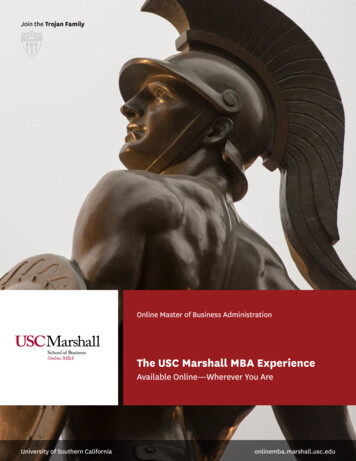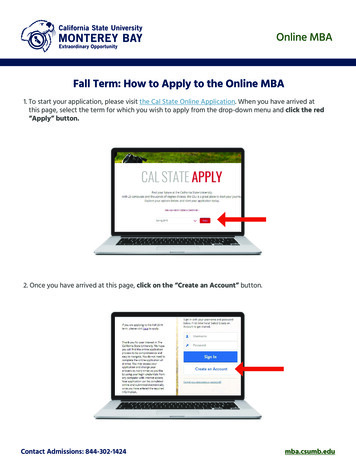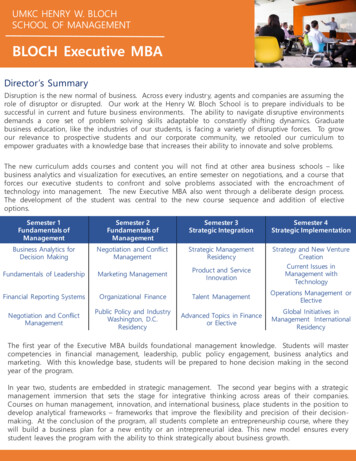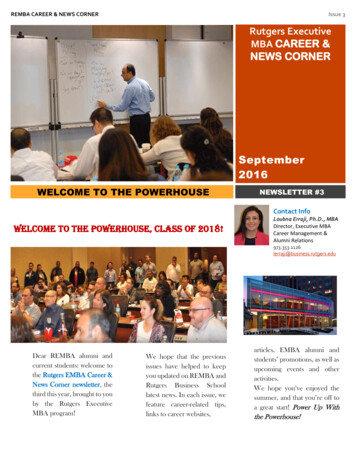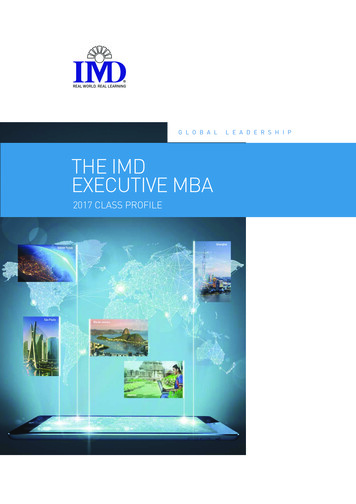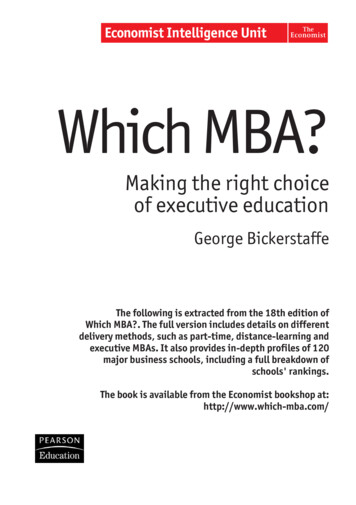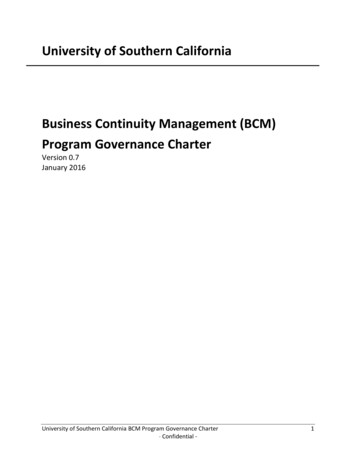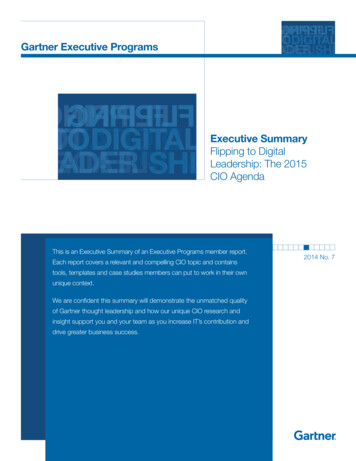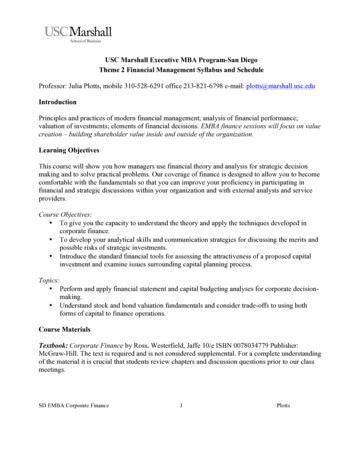
Transcription
USC Marshall Executive MBA Program-San DiegoTheme 2 Financial Management Syllabus and ScheduleProfessor: Julia Plotts, mobile 310-528-6291 office 213-821-6798 e-mail: plotts@marshall.usc.eduIntroductionPrinciples and practices of modern financial management; analysis of financial performance;valuation of investments; elements of financial decisions. EMBA finance sessions will focus on valuecreation – building shareholder value inside and outside of the organization.Learning ObjectivesThis course will show you how managers use financial theory and analysis for strategic decisionmaking and to solve practical problems. Our coverage of finance is designed to allow you to becomecomfortable with the fundamentals so that you can improve your proficiency in participating infinancial and strategic discussions within your organization and with external analysts and serviceproviders.Course Objectives: To give you the capacity to understand the theory and apply the techniques developed incorporate finance. To develop your analytical skills and communication strategies for discussing the merits andpossible risks of strategic investments. Introduce the standard financial tools for assessing the attractiveness of a proposed capitalinvestment and examine issues surrounding capital planning process.Topics: Perform and apply financial statement and capital budgeting analyses for corporate decisionmaking. Understand stock and bond valuation fundamentals and consider trade-offs to using bothforms of capital to finance operations.Course MaterialsTextbook: Corporate Finance by Ross, Westerfield, Jaffe 10/e ISBN 0078034779 Publisher:McGraw-Hill. The text is required and is not considered supplemental. For a complete understandingof the material it is crucial that students review chapters and discussion questions prior to our classmeetings.SD EMBA Corporate Finance1Plotts
HBS Cases:Hansson Private Label, Inc.: Evaluating an Investment in Expansion, Product #:4021-PDF-ENGSpyder Active Sports—2004, Product #:206027-PDF-ENGFinancial CalculatorYou are not required to purchase a financial calculator. However, financial calculators do simplifymany of the problems. I personally use the HP 12-C. I have also heard positive reviews of the TI-BAII Plus calculator.Course GradesYour final score will represent how you perform in the class relative to other students. In accordancewith the grading standards for Marshall MBA courses, all EMBA themes have a target average gradeof 3.4 (on a 4-point scale).Study Group Case Analysis Assignments (50% of your Theme 2 finance score)We will analyze real companies and work through problems by analyzing different scenarios andcourses of action. In your analysis of our two HBS case studies you should place yourself in the roleof the decision maker as you read through the situation and identify the problems and issues. The nextstep is to perform the necessary analysis. To get the most out of cases, you should read and reflect onthe case individually, and then meet in study group teams prior to class to “warm up” and discussyour findings with other classmates. In class we will probe underlying issues, compare differentalternatives, and finally, suggest courses of action in light of the objectives of the case.The cases have been included in the curriculum as a means to provide this self-study and practice inanalysis. Study groups will be asked to prepare a pre-session case study analysis on the HanssonPrivate Label and Spyder Active Sports 2004 cases.Work in a group of your choice (please do not exceed 6 students). If your group seeks clarification onmaterial presented in the case please e-mail your question to plotts@marshall.usc.edu and responseswill be compiled and sent to all members of the class.Case questions are listed in the syllabus. For both cases you will receive supplementary excelspreadsheets and a document with hints on how to approach the analysis. A case analysis summaryshould consist of a 3-4 page written executive summary addressing the case questions withsupporting computations and tables in a separate appendix (if relevant). All case assignments are dueon their respective due dates at the beginning of class. The cover sheet of each written assignmentshould contain the first and last names of the students submitting the assignment arrangedalphabetically. The submission process for your assignment will be through our reprographicsvendor, Trinity Reprographics, who will subsequently print all the files and send them to Prof. Plottsin a bulk distribution. Please submit your project on time.SD EMBA Corporate Finance2Plotts
Trinity Reprographics Case Submission Process: Don’t forget to put your name (list all names) on Page 1 of the document. Please submit onlyone project per group. Send an email to Trinity Reprographics usc.edu and plotts@marshall.usc.edu Fill in your name(s) in the subject line of the email after “Project for Julia Plotts” If you want to confirm your assignment was received, please cc: yourself when sendingit. This will assure you that it has been sent and can serve as your receipt confirmation. Attach your file and send.Theme 2 Finance Quizzes (50% of Theme 2 Finance score). There will be two multiplechoice/short answer quizzes during Theme 2 Finance. The dates of the quizzes are noted in theschedule.Optional Text Practice ProblemsRecommended text problems will not be collected or graded. They are optional. The problems maysolidify your understanding of the key course concepts.Chapter4398561011Optional Additional Practice Problems2, 3, 7, 11, 12, challenge: 13, 14, 26, 281, 6, 10, 111, 2, 3, 4, 8, 11, 14, challenge: 25, 271, 2, 3, 5, 7, 12, 14, 15,1, 16b1, 2, 9, Hansson calculations, challenge: 231, 2, 4, 7, 91, 2, 3, 5, 7, 13-16, 28aSD EMBA Corporate Finance3Plotts
Schedule for Theme 1Theme 1Topic/Learning Objective/Discussion QuestionsCourse Introduction and Time Value of MoneyDiscounted Cash Flow Valuation: To understand discounted cash flow techniques for enhanced valuationapplications. To understand differences between simple and compound interest. To understand the accounting and financial statement implications ofcompound interest. Understand how to compute present value, future value and the netpresent value of any set of cash flows and apply shortcuts to valuespecial sets of regular cash flows called perpetuities and annuities. We will review Mathematical Tables in Appendix 1 (pages 974-981) forsolving time value of money calculations without the use of a financialcalculator.SD EMBA Corporate Finance4ReadingRWJ Chapters1, 4Plotts
Schedule for Theme 2October 24-25 morning sessionsDate10/2410/25Topic/Learning Objective/Discussion QuestionsTheme 1 Review, Financial Statements, Performance Measurement What do the numbers mean? We will discuss tools for analyzingcompany strategy and financial performance. We will focus on thefollowing key areas:1. Profit “How much money is the company making?”: Find the answeron the P&L (Profit and Loss Statement aka Income Statement). Profitdescribes how much profit was earned or losses incurred over acertain period of time. Other words for profit are earnings, netincome, and the bottom line. More profit is good, but cash flow iseven better.2. Balance Sheet Strength: This is an analysis of a company’s assetsrelative to its liabilities at a specific point in time. Generally moreassets (what the company owns) and fewer liabilities (what thecompany owes) result in a stronger balance sheet.3. Cash Flow: The difference between the amount of cash you end upwith at the end of a certain period of time versus how much youstarted with. More positive cash flow is good. Cash is King!Decision-making rests on after-tax cash flows (rather than othermetrics). Note: this is where I attempt a reversal of ProfessorDeFond’s brainwashing techniques.4. Ratios: Learning What the Numbers Are Really Telling You. Thefinancial statements tell a story through performance ratios such asprofitability, leverage, liquidity, efficiency, return on investment.We will interpret and analyze financial statements and ratiosincluding market value measures such as P/E ratio, market/book ratio,enterprise value multiples.Valuing Stocks ders? We will discuss how to utilize a DuPont approach in corporate andstrategic analysis. This will allow us to consider external financingand growth. We will calculate and interpret internal and sustainablegrowth rates for firms and will discuss the determinants of growth. We will discuss how are stocks valued through the application of adiscounted cash flow model. We will consider both dividends paidand capital gains and the impact of growth opportunities: net presentvalue of growth opportunities (NPVGO).SD EMBA Corporate Finance5Reading andDeliverableRWJ Chapters 2-3RWJ Chapter 3,Chapter 9Quiz #1Plotts
Date11/711/8Schedule for Theme 2November 7-8 afternoon sessionsTopic/Learning Objective/Discussion QuestionsInterest Rates and Valuing Bonds Gain fundamental insights into the valuation of debt (government andcorporate bonds). Understand the relationship between market interest ratesand bond prices and the implications for firms’ borrowing rates. What does the term capital structure mean and why do some companies decideto utilize debt to finance operations? In May 2009 Microsoft raised capital through its first-ever bond offering. Atthe time of the offering MSFT had 25.3 billion in cash and equivalents. Acompany spokesperson stated, “the company is not in need of financing.” InSeptember 2010 MSFT sold 4.75 billion in debt at the lowest corporateborrowing rates on record for its three-year notes. In April 2013 Apple raised 17 billion in a record debt offering. Prior to our class session, research theterms of these debt offerings and the current quote. Both companies have hugecash “war chests” and historically have never utilized debt. What is theincentive to sell the bonds?Capital Budgeting Introduce the standard tools for assessing the attractiveness of a proposedcapital investment; discuss the complementing of DCF analysis with industryanalysis; examine issues surrounding the capital planning process. Which capital budgeting methods should companies be using? When performing capital budgeting sunk costs must be ignored, whereasopportunity costs and side effects must be considered. Try to think of a fewreal life examples of where this might be difficult. Review the steps in the Baldwin Company example in the text.Article of Interest: Inside the secret world of Trader Joe's http://tinyurl.com/297usn3Hansson Private Label (HBS Case): financial exhibits will be provided in excel. Evaluate HPL’s historical financial performance. How has HPL performed?Consider historical ROE decomposition and analysis of financial performanceratios and peer comparison. Utilizing the data provided, determine whether the expansion project is attractivein strategic and economic terms. Calculate the total project cash flows, NPV,IRR, and payback period given the supplied project forecasts. Perform asensitivity analysis. Will the expansion position HPL for any form of sustainable competitiveadvantage? Will it allow HPL to improve long-term profitability? If HPL wantsto decline the proposal, what practical alternatives does he have? What are the risks of the investment? What might be done to mitigate theserisks?SD EMBA Corporate Finance6PlottsReadingDeliverableRWJChapter 8RWJChapters 5-6HanssonGroup Case(25%)
Date12/1212/131Schedule for Theme 2December 12-13 afternoon sessionsTopic/Learning Objective/Discussion QuestionsRisk and Cost of Capital Business is risky. You might not get paid by a customer, you might default ona bank loan, your company might get sued, etc. Risk typically is defined interms of probabilities of certain outcomes. We will discuss the risk/rewardrelationship and methods to quantify risk. Consider the historical relationship between the risk and return tradeoff, andits implications to corporate finance and the opportunity cost of capital forcorporations. Building upon the knowledge gained from Professor Porter’s statisticssessions, we can utilize statistical concepts such as regression analysis to helpus understand financial risk. Identify which types of securities have historically had the highest returnsand which have been the most volatile. Understand the definition of risk infinance. Why is there an equity risk premium? Understand the concept of diversification and the difference betweensystematic and unsystematic risk. Which type of risk matters to investors? Describe the capital asset pricing model (CAPM).Intro to ValuationSpyder Active Sports (HBS Case) financial exhibits will be provided in excel. There are many approaches to determine fair market value (FMV) of a firm.We will discuss discounted cash flow and the market multiples approach. Identify the different “exit” options that are feasible for Spyder in 2004, andanalyze the benefits and costs of each alternative. Consider the interests andneeds of the owner(s), the current state and future prospects of the company,and the current state of the financial markets. Perform a discounted cash flow valuation analysis to determine the value ofSpyder. What are the risks to the valuation? Perform sensitivity analysis andaddress the uncertainty in the assumptions and valuation approach. Spyder is not publicly traded; but we can still apply the market approach(price multiples) to estimate the company’s implied value. Evaluate thefinancial data provided for Spyder and also the comparable publicly-tradedcompany price multiples (Exhibit 11) and comparable past merger andacquisition multiples (Exhibit 9) to determine an estimated “implied” valuefor the company in 2004.1 Compare the alternative transactions descri
analysis. Study groups will be asked to prepare a pre-session case study analysis on the Hansson Private Label and Spyder Active Sports 2004 cases. Work in a group of your choice (please do not exceed 6 students). If your group seeks clarification on material presented in the case please e-mail your question to plotts@marshall.usc.edu and responses
